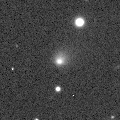
|
Already very bright, much brighter than expected, as 10.5 mag (Jan. 3, Alexandre Amorim). Not observable now. It is expected to keep so bright as 6-8 mag for a long time from 2011 to 2012, and to be observable in good condition in the Northern Hemisphere. It will appear in the morning sky in late March in the Southern Hemisphere, or in late April in the Northern Hemisphere.
Date(TT) R.A. (2000) Decl. Delta r Elong. m1 Best Time(A, h)
Mar. 5 22 29.26 -18 37.1 4.850 3.898 14 12.4 5:01 (280,-18)
Mar. 12 22 33.25 -17 35.2 4.756 3.831 19 12.3 4:52 (281,-15)
|
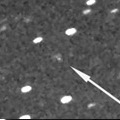
|
Now it is 14.5 mag (Mar. 4, A. Novichonok and D. Chestnov). It will be fading after this. The condition in this apparition is bad. It will be getting higher gradually after this in the Southern Hemisphere, however, it keeps extremely low until May in the Northern Hemisphere.
Date(TT) R.A. (2000) Decl. Delta r Elong. m1 Best Time(A, h)
Mar. 5 20 28.04 -23 8.8 2.216 1.596 40 12.8 5:01 (300, 2)
Mar. 12 20 48.84 -22 26.3 2.204 1.619 42 12.9 4:52 (300, 2)
|

|
Now it is so bright as 13.1 mag (Mar. 6, Hidetaka Sato). Diffuse object, with a large coma of 3 arcmin. It can be visible visually. Tiny comet. But it will approach to the sun down to 0.9 A.U. and brighten up to 11-12 mag. It keeps observable until it fades out, although it keeps locating somewhat low in the morning sky.
Date(TT) R.A. (2000) Decl. Delta r Elong. m1 Best Time(A, h)
Mar. 5 18 0.73 -15 7.0 0.971 1.180 73 13.2 5:01 (323, 31)
Mar. 12 18 45.45 -12 41.7 0.930 1.104 69 12.8 4:52 (315, 30)
|

|
Now it is 13.5 mag (Mar. 1, Carlos Labordena). Not very bright, but visible visually.
Date(TT) R.A. (2000) Decl. Delta r Elong. m1 Best Time(A, h)
Mar. 5 10 59.73 -0 13.9 5.264 6.250 173 13.6 0:12 ( 0, 55)
Mar. 12 10 56.63 0 1.1 5.266 6.250 171 13.6 23:37 ( 0, 55)
|

|
Big asteroid discovered in 1906. It suddenly showed the cometary activity on Dec. 11, probably due to an impact of a small object. It was very bright as 11.5 mag visually (Dec. 17, Juan Jose Gonzalez). It had a dust coma still on Jan. 9 (Joseph Brimacombe). Now it is stellar at 13.6 mag (Feb. 5, Juan Jose Gonzalez).
Date(TT) R.A. (2000) Decl. Delta r Elong. m1 Best Time(A, h)
Mar. 5 9 11.10 36 30.7 2.145 2.980 140 13.7 22:19 (180, 89)
Mar. 12 9 6.59 36 26.8 2.191 2.968 134 13.8 21:47 (180, 89)
|
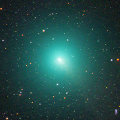
|
It approached to the earth down to 0.12 A.U. and brightened up to 4.6 mag in October (Oct. 18, Juan Jose Gonzalez). It was very large, double of the full moon, and very bright, visible with naked eyes. Now it is fading, but still bright as 11.7 mag (Mar. 1, Carlos Labordena). After this, it keeps observable for a long time until June when it fades down to 17 mag.
Date(TT) R.A. (2000) Decl. Delta r Elong. m1 Best Time(A, h)
Mar. 5 7 19.69 -0 30.1 1.175 1.919 124 13.7 20:29 ( 0, 55)
Mar. 12 7 26.10 0 47.3 1.289 1.981 119 14.0 20:08 ( 0, 56)
|

|
A small outburst occured and it brightened by 2 mag, up to 16.1 mag, on 2010 Aug. 31 (Bernhard Haeusler). Now it is 15.5 mag (Feb. 5, Toshiyuki Takahashi). It will brighten up to 11.5 mag in autumn. In the Northern Hemisphere, it keeps observable for a long time until 2012 spring. In the Southern Hemisphere, it is not observable until November.
Date(TT) R.A. (2000) Decl. Delta r Elong. m1 Best Time(A, h)
Mar. 5 17 54.36 45 57.0 2.796 2.890 85 14.3 5:01 (236, 64)
Mar. 12 18 3.11 49 51.5 2.709 2.835 86 14.2 4:52 (226, 64)
|
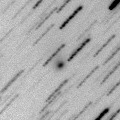
|
Now it is 13.3 mag, much brighter than originally expected and visible visually (Jan. 24, Juan Jose Gonzalez). In the Southern Hemisphere, it will be unobservable until spring. In the Northern Hemisphere, the altitude will be lower than 10 degree from February to April.
Date(TT) R.A. (2000) Decl. Delta r Elong. m1 Best Time(A, h)
Mar. 5 22 41.10 22 1.4 3.373 2.549 28 14.4 5:01 (245, 3)
Mar. 12 22 49.70 21 5.6 3.414 2.561 26 14.5 4:52 (247, 4)
|
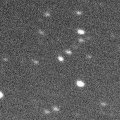
|
Now it is 14.4 mag (Feb. 27, Tzec Maun Observatory). It keeps bright as 14-15 mag for a long time after this until 2013. It is not observable in the Northern Hemisphere, but it is observable in good condition in the Southern Hemisphere.
Date(TT) R.A. (2000) Decl. Delta r Elong. m1 Best Time(A, h)
Mar. 5 16 37.91 -70 44.3 5.873 5.886 85 14.5 5:01 (356,-16)
Mar. 12 16 39.02 -72 16.7 5.779 5.867 90 14.5 4:52 (357,-17)
|
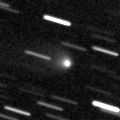
|
It is already bright as 14.5 mag and visible visually (Sept. 30, Alan Hale). It is appearing in the morning sky in the Northern Hemisphere. It will be observable in late March also in the Southern Hemisphere. It will be observable at 13-14 mag for a long time from 2011 to 2012.
Date(TT) R.A. (2000) Decl. Delta r Elong. m1 Best Time(A, h)
Mar. 5 20 28.80 -6 21.9 6.730 5.976 37 15.0 5:01 (287, 13)
Mar. 12 20 29.78 -6 10.1 6.623 5.950 44 14.9 4:52 (290, 16)
|
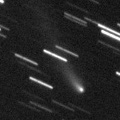
|
Now it is 13.5 mag and visible visually (Feb. 4, Juan Jose Gonzalez). It has a long tail by CCD observations. It keeps observable at 14-15 mag in good condition until spring.
Date(TT) R.A. (2000) Decl. Delta r Elong. m1 Best Time(A, h)
Mar. 5 4 32.82 -16 34.3 2.931 2.953 81 15.1 19:22 ( 29, 33)
Mar. 12 4 31.62 -16 52.6 3.042 2.960 75 15.2 19:28 ( 37, 29)
|
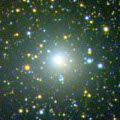
|
It reached up to 7.7 mag in 2009 summer (2009 Aug. 13, Chris Wyatt). Now it is fading, but still bright as 13.7 mag (Feb. 7, A. Novichonok, D. Chestnov). It will never be observable again in the Northern Hemisphere. In the Southern Hemisphere, it keeps observable in good condition until 2011 autumn when it becomes fainter than 18 mag.
Date(TT) R.A. (2000) Decl. Delta r Elong. m1 Best Time(A, h)
Mar. 5 18 24.20 -55 27.3 6.472 6.255 73 15.5 5:01 (339, -6)
Mar. 12 18 24.42 -56 20.5 6.417 6.304 79 15.5 4:52 (342, -6)
|
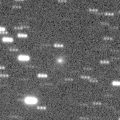
|
Now it is 14.2 mag (Feb. 7, Artyom Novichonok), much brighter than originally expected. It keeps 15 mag until 2011 spring. It keeps observable in good condition in the Southern Hemisphere. In the Northern Hemisphere, it becomes observable in the evening low sky only in March and April.
Date(TT) R.A. (2000) Decl. Delta r Elong. m1 Best Time(A, h)
Mar. 5 5 46.07 -42 52.6 2.849 3.080 93 15.7 19:22 ( 5, 12)
Mar. 12 5 43.78 -38 53.5 2.926 3.108 91 15.9 19:28 ( 13, 15)
|
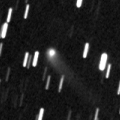
|
Now it is 15.2 mag (Nov. 27, A. Novichonok and D. Chestnov). It will be fading very slowly after this. In the Northern Hemisphere, it keeps observable for a long time until 2012 spring when it fades down to 17-18 mag. It will not be observable in the Southern Hemisphere.
Date(TT) R.A. (2000) Decl. Delta r Elong. m1 Best Time(A, h)
Mar. 5 21 10.54 36 30.5 5.261 4.685 50 15.8 5:01 (243, 27)
Mar. 12 21 20.06 37 17.9 5.272 4.701 50 15.8 4:52 (243, 29)
|
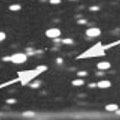
|
Now it is 15.7 mag (Jan. 23, Toru Yusa). In the Northern Hemisphere, it keeps observable in good condition until 2011 spring when it brightens up to 16 mag. In the Southern Hemisphere, it keeps locating low.
Date(TT) R.A. (2000) Decl. Delta r Elong. m1 Best Time(A, h)
Mar. 5 5 6.01 38 6.3 2.022 2.328 94 16.3 19:22 (108, 76)
Mar. 12 5 15.16 38 1.0 2.083 2.307 89 16.3 19:28 (106, 72)
|
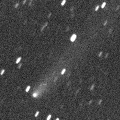
|
Now it is 17.2 mag (Feb. 21, Ken-ichi Kadota). It keeps observable after this while fading gradually.
Date(TT) R.A. (2000) Decl. Delta r Elong. m1 Best Time(A, h)
Mar. 5 13 13.19 -28 19.7 1.960 2.733 132 16.4 2:25 ( 0, 27)
Mar. 12 13 7.78 -28 2.1 1.943 2.779 140 16.5 1:52 ( 0, 27)
|
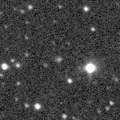
|
Now it is 16.5 mag (Mar. 1, P. C. Sherrod). It keeps 15 mag from 2011 summer to 2012 summer. But it is not observable around the perihelion. It is observable in good condition in the Northern Hemisphere in 2011, and in the Southern Hemisphere in 2012.
Date(TT) R.A. (2000) Decl. Delta r Elong. m1 Best Time(A, h)
Mar. 5 13 41.36 21 45.8 3.027 3.825 138 16.7 2:53 ( 0, 77)
Mar. 12 13 40.31 22 48.7 2.934 3.770 142 16.6 2:24 ( 0, 78)
|
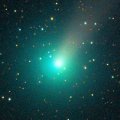
|
It brightened up to 7.9 mag in April and May (May 5, Juan Jose Gonzalez). Now it is fading. It has already faded down to 16.5 mag (Feb. 23, Tzec Maun Observatory). It keeps observable for a long time until when it fades out in the Northern Hemisphere. It is not observable in the Southern Hemisphere.
Date(TT) R.A. (2000) Decl. Delta r Elong. m1 Best Time(A, h)
Mar. 5 4 8.96 27 8.0 4.105 4.078 81 16.6 19:22 ( 82, 62)
Mar. 12 4 11.36 26 24.4 4.292 4.146 74 16.8 19:28 ( 86, 56)
|
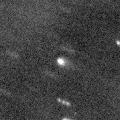
|
It will approach to the sun down to 0.5 A.U. in September, and it is expected to brighten up to 6 mag. Now it is 16.6 mag (Mar. 2, J. F. Soulier, J. Soulier). It will be brightening gradually. In the Southern Hemisphere, it keeps observable until early September when it becomes 7 mag. In the Northern Hemisphere, it becomes unobservable in August. But after appearing in the morning sky in October, it becomes observable in the excellent condition at midnight.
Date(TT) R.A. (2000) Decl. Delta r Elong. m1 Best Time(A, h)
Mar. 5 11 44.68 0 15.0 2.245 3.220 167 16.8 0:57 ( 0, 55)
Mar. 12 11 37.03 1 1.1 2.140 3.132 176 16.6 0:22 ( 0, 56)
|
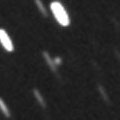
|
Now it is 16.3 mag (Feb. 24, Hiroshi Abe). It is expected to be 14 mag and will be observable in good condition in 2013. In the Northern Hemisphere, it keeps observable for a long time after this, although it becomes low temporarily in spring. It is not observable in the Southern Hemisphere.
Date(TT) R.A. (2000) Decl. Delta r Elong. m1 Best Time(A, h)
Mar. 5 1 32.65 53 58.0 8.410 8.094 68 16.7 19:22 (135, 39)
Mar. 12 1 34.27 53 47.1 8.461 8.063 63 16.7 19:28 (136, 34)
|

|
It had been bright as 13-14 mag for a long time from 2007 to 2009. Now it is fading, but it is still bright as 14.4 mag and visible visually (Feb. 7, Sandor Szabo). It keeps observable at 15-16 mag in good condition until spring.
Date(TT) R.A. (2000) Decl. Delta r Elong. m1 Best Time(A, h)
Mar. 5 11 17.80 42 9.4 8.798 9.618 143 16.8 0:30 (180, 83)
Mar. 12 11 12.41 42 23.6 8.860 9.654 141 16.8 23:52 (180, 83)
|
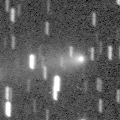
|
It reached up to 14.0 mag and became visible visually in December (Dec. 17, Juan Jose Gonzalez). It keeps locating high in the Northern Hemisphere after this. But it will be fading. It has already faded down to 16.6 mag (Mar. 1, Tzec Maun Observatory). It will be fainter than 18 mag in April. It locates low in the Southern Hemisphere.
Date(TT) R.A. (2000) Decl. Delta r Elong. m1 Best Time(A, h)
Mar. 5 6 20.24 44 16.2 1.918 2.424 108 16.9 19:30 (180, 81)
Mar. 12 6 27.52 44 3.5 2.020 2.449 103 17.1 19:28 (160, 80)
|
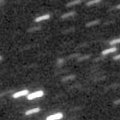
|
Now it is 17.0 mag (Feb. 4, D. Chestnov and A. Novichonok). In the Northern Hemisphere, it keeps observable at 17 mag in good condition until summer. It locates low in the Southern Hemisphere.
Date(TT) R.A. (2000) Decl. Delta r Elong. m1 Best Time(A, h)
Mar. 5 18 13.02 22 16.6 4.114 3.990 75 17.1 5:01 (283, 56)
Mar. 12 18 10.60 24 4.6 4.026 4.001 81 17.1 4:52 (284, 61)
|
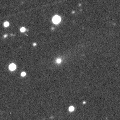
|
Now it is 17.7 mag (Jan. 30, Tzec Maun Observatory). It was observed around 16 mag in 2009 and 2010. In 2011, it keeps observable at 17 mag from spring to autumn. It locates somewhat low in the Northern Hemisphere.
Date(TT) R.A. (2000) Decl. Delta r Elong. m1 Best Time(A, h)
Mar. 5 17 27.24 -22 12.6 4.045 4.020 81 17.1 5:01 (334, 28)
Mar. 12 17 31.52 -22 20.2 3.948 4.029 87 17.1 4:52 (338, 29)
|
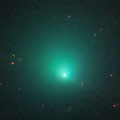
|
It has kept bright as 8.5 mag since July until September. Now it is fading. Diffuse object, but the total magnitude is still bright as 15.7 mag (Feb. 22, Tzec Maun Observatory).
Date(TT) R.A. (2000) Decl. Delta r Elong. m1 Best Time(A, h)
Mar. 5 2 52.06 7 19.0 2.982 2.618 59 17.1 19:22 ( 71, 37)
Mar. 12 3 1.99 8 25.6 3.102 2.660 55 17.3 19:28 ( 77, 33)
|

|
It was observed only during 3 days in 2009 May, then it has been lost. The ephemeris says that it passes the perihelion in 2011 January and it will be observable at 17 mag. But actually, it will not be found.
Date(TT) R.A. (2000) Decl. Delta r Elong. m1 Best Time(A, h)
Mar. 5 5 37.39 -12 11.5 3.675 3.931 97 17.3 19:22 ( 12, 42)
Mar. 12 5 31.34 -11 6.4 3.803 3.938 90 17.4 19:28 ( 25, 41)
|
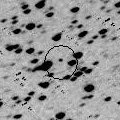
|
Large Centaur-type asteroid. Now it is 17.0 mag (Jan. 7, Tzec Maun Observatory). It keeps observable at 17-18 mag for a long time until 2013.
Date(TT) R.A. (2000) Decl. Delta r Elong. m1 Best Time(A, h)
Mar. 5 7 19.20 -9 22.3 5.898 6.486 122 17.4 20:28 ( 0, 46)
Mar. 12 7 16.59 -8 14.5 5.981 6.486 116 17.5 19:58 ( 0, 47)
|
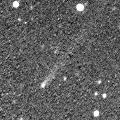
|
Now it is 17.6 mag (Feb. 24, La Sagra). It tends to be brightest after the perihelion passage. At the discovery in 1999, it became brightest one year after the perihelion passage. At this time, it became brightest three months after the perihelion passage, then it is fading. It keeps observable in good condition at 18 mag until may.
Date(TT) R.A. (2000) Decl. Delta r Elong. m1 Best Time(A, h)
Mar. 5 10 6.44 8 42.0 2.789 3.760 166 17.5 23:14 ( 0, 64)
Mar. 12 10 2.57 9 2.3 2.835 3.777 158 17.6 22:43 ( 0, 64)
|
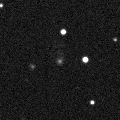
|
Now it is 17.3 mag (Feb. 21, Ken-ichi Kadota). It is fading slowly. In the Northern Hemisphere, it keeps observable in good condition until 2011 summer. It is not observable in the Southern Hemisphere.
Date(TT) R.A. (2000) Decl. Delta r Elong. m1 Best Time(A, h)
Mar. 5 17 39.74 44 55.9 5.362 5.413 87 17.6 5:01 (236, 67)
Mar. 12 17 38.94 45 27.0 5.338 5.437 90 17.6 4:52 (232, 70)
|
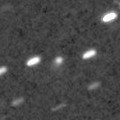
|
Asteroid discovered in 2002 was revealed to be a comet. Now it is 17.1 mag (Feb. 27, C. Rinner, F. Kugel). It will be fading after this, and will be fainter than 18 mag soon. It is observable in good condition in the Northern Hemisphere. It is not observable in the Southern Hemisphere.
Date(TT) R.A. (2000) Decl. Delta r Elong. m1 Best Time(A, h)
Mar. 5 7 48.33 47 52.2 0.866 1.624 121 17.7 20:58 (180, 77)
Mar. 12 8 2.74 45 55.6 0.930 1.656 118 18.0 20:45 (180, 79)
|

|
Now it is stellar at 17.3 mag (Feb. 12, Hidetaka Sato). Tiny periodic comet. It approaches to the sun down to 0.5 A.U. in mid April. But it brightens up to 17 mag only. In the Southern Hemisphere, it is observable in the morning sky until mid March. In the Northern Hemisphere, it locates extremely low.
Date(TT) R.A. (2000) Decl. Delta r Elong. m1 Best Time(A, h)
Mar. 5 18 41.11 -28 6.7 0.797 0.974 64 17.8 5:01 (322, 15)
Mar. 12 19 43.81 -24 47.0 0.775 0.872 57 17.7 4:52 (312, 12)
|
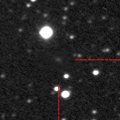
|
Now it is 17.4 mag (Feb. 24, La Sagra). It was observed at 18 mag in winter between 2009 and 2010. It will be observable again at 18 mag in good condition from winter to spring in 2011.
Date(TT) R.A. (2000) Decl. Delta r Elong. m1 Best Time(A, h)
Mar. 5 10 38.18 13 22.7 2.500 3.483 171 17.8 23:46 ( 0, 68)
Mar. 12 10 33.98 13 50.7 2.524 3.488 163 17.8 23:14 ( 0, 69)
|
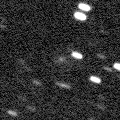
|
Now it is 16.7 mag (Feb. 16, L. Elenin and A. Novichonok). Diffuse object, but the total magnitude is bright. It keeps 17-18 mag until April.
Date(TT) R.A. (2000) Decl. Delta r Elong. m1 Best Time(A, h)
Mar. 5 14 40.77 -9 51.6 0.989 1.739 122 17.9 3:52 ( 0, 45)
Mar. 12 14 43.41 -10 13.4 0.965 1.768 129 17.9 3:27 ( 0, 45)
|

|
It is expected to keep 14-15 mag for a long time from 2011 summer to 2012 summer. The condition is good in the Southern Hemisphere, and it keeps observable for a long time. In the Northern Hemisphere, it is observable in the low sky in 2011 spring. But after that, it is not observable until 2012 August. However, this comet was observed only during two days in 2010 June. So the orbital elements are extremely uncertain.
Date(TT) R.A. (2000) Decl. Delta r Elong. m1 Best Time(A, h)
Mar. 5 18 20.44 -23 14.0 4.509 4.259 69 18.1 5:01 (323, 22)
Mar. 12 18 24.14 -23 58.9 4.343 4.204 75 17.9 4:52 (326, 23)
|
|
![]()
 29P/Schwassmann-Wachmann 1
29P/Schwassmann-Wachmann 1 (596) Scheila
(596) Scheila 103P/Hartley 2
103P/Hartley 2 C/2010 G2 ( Hill )
C/2010 G2 ( Hill ) C/2009 Y1 ( Catalina )
C/2009 Y1 ( Catalina ) C/2009 F4 ( McNaught )
C/2009 F4 ( McNaught ) C/2006 S3 ( LONEOS )
C/2006 S3 ( LONEOS ) C/2010 B1 ( Cardinal )
C/2010 B1 ( Cardinal ) C/2006 W3 ( Christensen )
C/2006 W3 ( Christensen ) C/2010 FB87 ( WISE-Garradd )
C/2010 FB87 ( WISE-Garradd ) C/2008 FK75 ( Lemmon-Siding Spring )
C/2008 FK75 ( Lemmon-Siding Spring ) 123P/West-Hartley
123P/West-Hartley 43P/Wolf-Harrington
43P/Wolf-Harrington C/2011 A3 ( Gibbs )
C/2011 A3 ( Gibbs ) C/2009 K5 ( McNaught )
C/2009 K5 ( McNaught ) C/2010 X1 ( Elenin )
C/2010 X1 ( Elenin ) C/2010 S1 ( LINEAR )
C/2010 S1 ( LINEAR ) C/2005 L3 ( McNaught )
C/2005 L3 ( McNaught ) 240P/2010 P1 ( NEAT )
240P/2010 P1 ( NEAT ) C/2009 UG89 ( Lemmon )
C/2009 UG89 ( Lemmon ) 74P/Smirnova-Chernykh
74P/Smirnova-Chernykh 10P/Tempel 2
10P/Tempel 2 C/2009 K3 ( Beshore )
C/2009 K3 ( Beshore ) 2008 YB3
2008 YB3 203P/2008 R4 ( Korlevic )
203P/2008 R4 ( Korlevic ) C/2007 VO53 ( Spacewatch )
C/2007 VO53 ( Spacewatch ) 247P/2010 V3 ( LINEAR )
247P/2010 V3 ( LINEAR ) 249P/2011 A4 ( LINEAR )
249P/2011 A4 ( LINEAR ) 31P/Schwassmann-Wachmann 2
31P/Schwassmann-Wachmann 2 P/2011 A2 ( Scotti )
P/2011 A2 ( Scotti ) C/2010 M1 ( Gibbs )
C/2010 M1 ( Gibbs )![]()





























